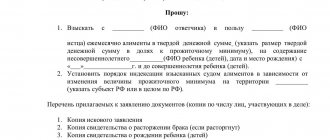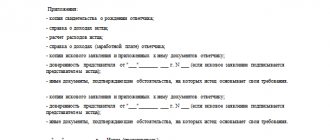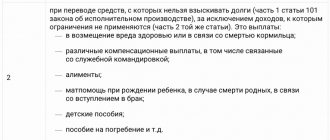After completing the trial, making a decision on the payment of alimony and receiving a writ of execution, most plaintiffs expect to receive monetary support. But the situation does not always develop this way. There are times when penalties are not paid and the reasons for this are different. What to do in this case? You need to submit an application to the bailiffs to collect alimony.
Since the writ of execution has already been received, it must be transferred to the service that will deal with the issue of collections. You can go to the place of work of your ex-spouse, especially if he does not shy away from supporting the child. Otherwise, it is better to contact the federal bailiff service. These are people in public service whose duty it is to enforce court decisions. And the issue of paying alimony also relates to their field of activity.
Powers of the FSSP
To begin work on debt collection, you need to provide a writ of execution obtained in court and write a statement to the bailiff.
This will become the basis for starting production. The main powers of bailiffs include:
- call the plaintiff and defendant, public service employees to clarify data, collect information for what reason alimony payments are not being made;
- the ability to have access to certain information, study documents and facts. Request information from the defaulter’s place of employment in order to find out his salary, make inquiries about property and material benefits;
- negotiate with the defendant’s management so that part of the money for child support is deducted from his salary in accordance with the writ of execution. They must be transferred to the plaintiff within three days;
- visit the debtor, go to his home to check the financial status of the payer;
- seize personal belongings within the amount specified in the application for payment of alimony;
- freeze bank accounts and transfer funds to the applicant’s account within the agreed amount;
- not allow the defendant to travel abroad.
Methods for collecting awarded funds
After the opening of enforcement proceedings, the first thing the bailiff does is summon the defaulter to appear. Refusal to make an appointment to visit the FSSP department may be grounds for putting the debtor on the federal wanted list. During the conversation with the performer, the bailiff is required to provide the following information :
- The exact address of your temporary place of residence, if you do not live at your place of registration;
- Information about official work;
- Information on income for the current period;
- Information about the property.
If the debtor has provided all the necessary information, the bailiff sends a copy of the writ of execution to his employer to withhold part of the wages. If there is a large alimony debt, the withheld portion can reach 50-70% of the accrued salary.
Recently, malicious failure to pay alimony has become a criminal offense; therefore, the bailiff, in accordance with his powers, has the opportunity to initiate a criminal case if collection methods are not successful.
In cases where the debtor is not officially employed, the bailiff has the ability to suppress attempts to leave the country, depriving him of the right to leave until the debt is repaid. At the same time, a search takes place for all movable and immovable property belonging to the defaulter, with a view to its subsequent sale at auction.
What is the deadline for writing a statement to the bailiff?
The legislation does not indicate a clear period of time when you need to contact the bailiff service after a decision has been made in the case and a writ of execution has been issued with a sample application. To do this, you can choose any time before reaching full age. Although, even after 18 years of age, the child himself can apply to the executive service to receive the debt for the entire time. He can write such a statement within the next three years. If during this time there has been no such appeal, then the right to receive arrears of alimony payments becomes invalid.
After a court hearing, the recipient does not always contact the FSSP. Due to some personal reasons, he postpones the visit. Then, when collecting maintenance, not the entire period will be calculated, but only the last three years when there were no payments.
When everything is submitted on time, but alimony is not received, then a debt appears, and it is this that the bailiffs will return.
Inaction of bailiffs
If the recipient of alimony diligently submitted applications for recalculation of the debt for alimony, used current samples and contributed in every possible way to the work of the bailiffs, but no result was achieved, it is necessary to file a complaint about the inaction of the service employees. The applicant will receive a response in the form of a letter, as well as the right to change the service employee.
The complaint states:
- The circumstances that led the applicant to the conclusion that the bailiff was inactive;
- The essence of dissatisfaction with his work;
- Please appoint another bailiff or speed up the work of the current one.
What package of documents should be prepared?
To get started, bailiffs need a sample of one of the following papers:
- a writ of execution issued to the plaintiff; a maintenance order issued by the court;
- if the writ of execution was lost, then you need to obtain an extract from the court on the assignment of alimony obligations; if available, an agreement on the transfer of child support, endorsed by a responsible person (for example, a notary);
- You must also have an identity document (passport), documents of the child;
- account number and bank name to receive payments.
What is a child support order?
First of all, let us remind you that a court order is an executive document issued by a magistrate. Something between a court decision and a writ of execution. What's the difference? In a lawsuit, you receive a court decision. But after it comes into force, you will also need a writ of execution for forced execution, in the event that the defendant refuses to do this voluntarily. So, issuing an “order” helps save both time and paper.
Although, as Lyudmila Prokofyevna said, the main “mymra” of the Soviet film “Office Romance”: “Our paper industry works excellently.” But still, let's remember that nature, our mother, must be protected.
How to write an application to the bailiffs for the collection of alimony?
In addition to all the documents mentioned above, to begin proceedings, you need to write a debt collection application. The form (sample) of such an application can be downloaded from the FSSP website. Here we will clarify only a few points.
- In the header of the application, you must correctly indicate the information of the head of the department where the package of documents will be provided.
- Next you need to write the plaintiff’s information - full name, registration address, number, series of passport, when issued.
- After this comes the text of the application for the collection of alimony. Be sure to indicate the registration number of the writ of execution that is attached, the name of the court that issued it and the date of receipt.
- Also indicate all the details of the defendant. If his place of residence and work is known, this is also written.
- The amount of the payment and the details of the child to whom these payments are made must be indicated.
- Next, you should indicate the bank details of the account to which the funds will be transferred.
- You also need to write a list of documents that are attached to the application form.
Recalculation
The Law on Enforcement Proceedings provides the opportunity to index alimony through bailiffs. If the cost of living is officially increased, alimony collected in a fixed amount is subject to a corresponding increase.
The amount of the increase is determined in proportion to the increase in the cost of living for the corresponding population group established in the Russian Federation. The bailiff is obliged to make a decision on the indexation of alimony.
Read more about the procedure for recalculating alimony in a separate article on our website.
What are the functions of bailiffs?
When the application form is completed, it is handed over to the senior bailiff, the head of the service. After familiarizing himself with the cases, he distributes them among employees, who, in turn, must begin the enforcement process within three days. To begin with, the bailiff can personally talk with the payer and try to agree on a voluntary payment of alimony. If such a conversation was successful, then the terms for depositing money, the amount and the need to notify the bailiff about all transfers are established.
In case of refusal to pay alimony obligations, the bailiff begins forced collection of the debt. He sends requests to the debtor’s place of work, to various authorities and services to obtain information about the financial situation, the availability of property, and family composition.
The whole process of finding out information, studying the application, talking and trying to collect money takes a lot of time. And bailiffs have more than one or two such cases at the same time. Therefore, after the application is written, the plaintiff sometimes has to independently monitor the progress of the case, search for the alimony payer and seize his property. To take this step, it is enough to submit a petition to the bailiff service:
- prohibiting the defendant from traveling to another state. Based on this ban, the spouse will not be able to leave the country for six months.
- Take custody of the defendant's property. The application must indicate its approximate cost and location. After the detention, the payer will not be able to use it, all property will be sold to pay off the maintenance debt.
- A request to collect interest on the amount of debt (penalty), which is added to the total amount of debt.
To pay and receive arrears of alimony, you need to go to court again and provide the full amount of the debt plus a penalty. Obtain a court order to collect this entire amount by force. Then submit this sample writ of execution to the FSSP. The bailiff, having received it, can proceed to the following actions:
- Money is necessarily withdrawn from the defendant’s salary. The figure is greater than the alimony obligation. Thus, both the alimony itself and the amount of debt are paid.
- Makes inquiries about other forms of income of the defaulter (inheritance, interest on bank deposits).
- The spouse's accounts are frozen, and the finances that are in them are transferred to the recipient of the maintenance to compensate for the debt.
- The payer's property is put up for auction, and the resulting amount is transferred to the plaintiff as alimony payments.
Submission order
If an application to the FSSP is being written for the first time, then it should be submitted in person through the office of the service (since some original documents may be needed when considering the application). When resubmitting, documents can be sent by mail or through the government services website. The following documents must be attached to the bailiff's application for non-payment of alimony :
- Passport (copy) of the applicant.
- Certificates of divorce/marriage, birth of children.
- Certificate of family composition (to confirm the fact of living with the child).
- Judicial writ of execution.
- Bank statements about the status of the alimony account.
- If possible, certificates of income of the defaulter (can be requested at his place of work).
- Other documents relevant to the case.
If the application is submitted in person, it should be made in two copies, one of which you should keep for yourself with a note of acceptance. In case of mailing, you need to make a copy of the receipt for payment of the letter with notification and a description of the attachment.
How to apply to search for alimony defaulter
Recipients most often think about searching for the alimony debtor after the payments have stopped.
To restore justice, it is enough to submit a search application to the bailiff service. Of course, all search activities must be carried out without any reminders. But if you have something additional to tell the bailiffs to speed up the process, you can use our example document.
A sample application to search for an alimony debtor looks like this:
The document can be changed and supplemented at your discretion. This version of the appeal can be compiled arbitrarily.








